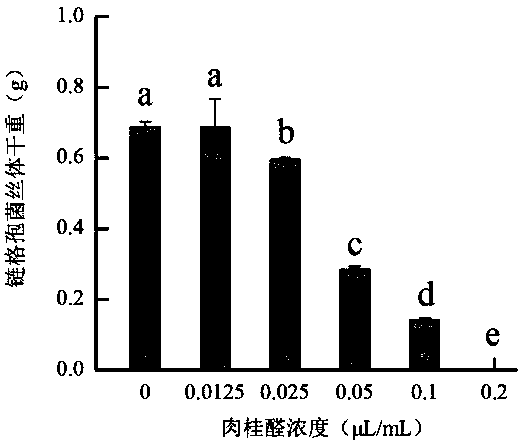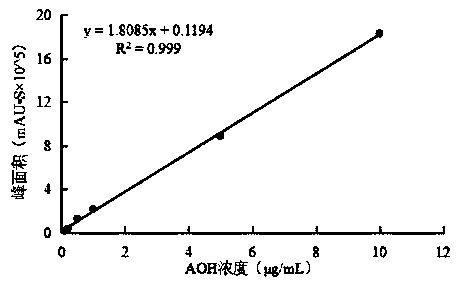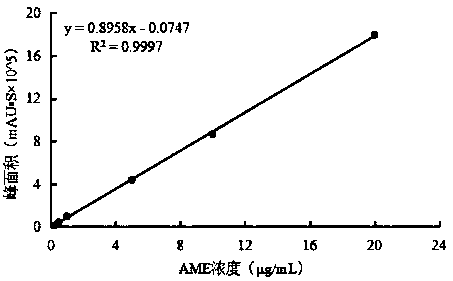Method for inhibiting the growth of Alternaria alternata and the accumulation of mycotoxins in Alternaria alternata
A technology of Alternaria sp. and mycotoxins is applied in the preservation of food ingredients as antimicrobials, food ingredients containing natural extracts, preservation of fruits and vegetables, etc., achieving good application prospects and market value, strong bacteriostatic properties, and stable performance. Effect
- Summary
- Abstract
- Description
- Claims
- Application Information
AI Technical Summary
Problems solved by technology
Method used
Image
Examples
Embodiment 1
[0045] Example 1 Effect of cinnamaldehyde on Alternaria mycelium growth
[0046] 1. The effect of direct contact with cinnamaldehyde on the growth of Alternaria
[0047] (1) Prepare potato dextrose broth (PDB), divide PDB medium into 150 mL Erlenmeyer flasks, 100 mL each, then add Tween-80 to the Erlenmeyer flasks to make the concentration 0.5%, At 121 °C, autoclave for 20 min;
[0048] (2) After the medium is sterilized in step (1), cool it down to 40-50 °C, add cinnamaldehyde to make the final concentrations 0.00, 0.0125, 0.025, 0.050, 0.100 and 0.200 μL / mL , shake well;
[0049] (3) Use a 6 mm round hole puncher to make a lawn in the culture dish of Alternaria for 5 days, take 2 pieces of lawn and inoculate them into the Erlenmeyer flask in the step (2), and store them at 25 °C , shaking culture under the condition of 150 rpm;
[0050] (4) After culturing for 96 h, the Alternaria hyphae in the step (3) were taken out, rinsed with sterile water for 3 times, filtered with...
Embodiment 2
[0056] Example 2 Degradation experiment of cinnamaldehyde to Alternaria mycotoxins AOH and AME
[0057] 1. Preparation of mycotoxin AOH standard curve
[0058] (1) Dissolve 1.0 mg AOH toxin standard substance in acetonitrile to prepare a standard stock solution with a concentration of 0.5 mg / mL. Take 0.2 mL of the stock solution and dilute to volume with methanol in a 10 mL volumetric flask to obtain AOH toxin standard solutions with a concentration of 10 μg / mL. The prepared standard solutions were stored in a -20°C refrigerator;
[0059] (2) According to the needs, prepare the standard use solution of AOH standard solution with the concentration of 0.10, 0.20, 0.50, 1.00, 5.00 and 10.00 μg / mL; Store in -20 °C refrigerator.
[0060] 2. Mycotoxin AME standard curve preparation
[0061] (1) Dissolve 1.0 mg AME toxin standard substance in acetonitrile to prepare a standard stock solution with a concentration of 0.5 mg / mL. Take 0.4 mL of the stock solution and dilute to volum...
PUM
 Login to View More
Login to View More Abstract
Description
Claims
Application Information
 Login to View More
Login to View More - R&D
- Intellectual Property
- Life Sciences
- Materials
- Tech Scout
- Unparalleled Data Quality
- Higher Quality Content
- 60% Fewer Hallucinations
Browse by: Latest US Patents, China's latest patents, Technical Efficacy Thesaurus, Application Domain, Technology Topic, Popular Technical Reports.
© 2025 PatSnap. All rights reserved.Legal|Privacy policy|Modern Slavery Act Transparency Statement|Sitemap|About US| Contact US: help@patsnap.com



